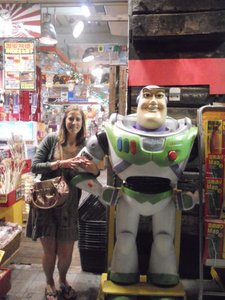Advertisement

 Kokusai Dori
Kokusai Dori
Buzz on the Boardwalk-like streetFor the Golden Week holiday, The Susan Team (my Canadian friend Susan and I) ventured to the
other Japan for a rejuvenating girls' retreat: Okinawa, baby.
The tanning, pina coladas-on-the-beach weather we daydreamed about at our desks left much to be desired. But, being a sunshine-spoiled Miami girl, it was easy to appreciate the physical and cultural beauty of the Hawaii-like islands without the sun.
We started in the sublimely sketchy Naha, the capital of Okinawa prefecture, where we mingled with some characters, shopped for beachy souvenirs and basically reveled in the swanky un-Japanese-ness of it all. It was Japan without the order, Southeast Asia without the beggars and the Jersey Shore without the English.
By night we found a guy serenading the side of a building from his balcony with what I've been calling a sitar, and by day we found some hooligans in board shorts putting their helplessly drunk friend into a car. 8am is too early for Okinawa.
While on the main island, we journeyed north to an aquarium, where we watched whale sharks and a dolphin show, and south to Okinawa's Peace Park and museum. It details the bloody land battle fought there
at the end of WW2 and continues through the current American military presence, at one point simulating a chilling city street under U.S. occupation. It was incredibly moving.
After Naha, we ferried to the tiny (2km) island of Aka-jima, where hitch-hiking is completely acceptable and civilization effectively ends. The locals (all 100 of them) wander around the island in wetsuits, hopping from beach to beach to snorkel the dense corals right offshore. Susie and I saw vibrant blue and yellow fish and a giant starfish in super close detail on our last day.
We also ferried to Zamami island to find a cafe, something Aka-jima failed to possess. Because it was pouring outside, we spent about five hours in relaxation heaven, with tatami mat cabanas, floor pillows, incense and a sleeping cat who kept us company while we snacked on sandwiches and hemp beer.
It would be easy to get lost on this chain of islands for several weeks, forgetting about real life in the company of extra friendly people and gorgeous beaches.
But it was also on Aka-jima, as fighter planes flew low over the white sand and rugged cliffs, that I really thought about
the the military bases and how they must affect the local people.
Okinawa used to be a separate country, and, in what seems to me to be similar story to that of the United States and Native Americans, Japan took over the islands and began a process of "assimilation" to Japanese culture. At the end of WW2, Japan sacrificed the Okinawans in the only land battle of the war on Japanese soil.
Since then, it has been host to an overwhelming and disproportionate American military presence, which has increased crime rates and become an explosive point of controversy. Locals have protested and appealed to the Japanese and American governments to move the bases, but the U.S. refuses.
Yet again, I felt uncomfortable about my nationality.
Okinawa is a beautiful place, where families gather to wave at the ferries as they leave the ports of the tiny islands, and strangers offered to help us everywhere we went. It's a terrible feeling to fall in love with a place and know that my country has caused and is causing it pain.
When I travel, instead of seeing destitute and limbless people who were blown up by American
bombs and landmines, like I saw in Cambodia, I want to see ways that my country has used its resources to treat other human beings with compassion and respect. Americans and the world America influences deserve a government that does that.
Advertisement
Tot: 0.209s; Tpl: 0.011s; cc: 8; qc: 54; dbt: 0.0584s; 1; m:domysql w:travelblog (10.17.0.13); sld: 1;
; mem: 1.1mb

 Kokusai Dori
Kokusai Dori